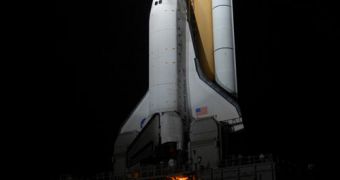NASA officials say that the space shuttle Discovery, which is due to fly to the International Space Station (ISS) in early November, is currently experiencing a minor fuel leak.
The spacecraft is currently installed at the Launch Pad 39A facility, which is located at the Kennedy Space Center (KSC), in Florida. It is being prepared for take-off on November 1.
At this point, engineers with the space agency are working around the clock to identify the damage and to repair it, and mission managers are hopeful that things will get fixed by the time Discovery needs to undergo safety tests.
The officials add that the malfunction that led to the leak took place in the aft compartment, where two propellant lines join to allow fuel to pass to the two orbital maneuvering system engines on the shuttle.
According to an official report, the leak was found as engineering crews noticed traces of monomethyl hydrazine on a damp insulating blanket around the area of the leak.
This chemical is one of two substances used to power up the two engines on either side of the spacecraft's tail, Space reports, and it shouldn't have been found outside the lines under any circumstance.
“It's clearly a very toxic chemical, so a lot of precautions have to be taken even with a very small leak like this,” explains Allard Beutel, a NASA spokesman.
Until now, engineers have tried tightening six large bolts that hold the seal in place, and teams are now waiting to see if that worked. If not, they may have to replace two seals in a dangerous operation.
“The processing schedule could allow the two seals to be replaced without delaying Discovery's targeted launch on Nov. 1,” Beutel adds.
This type of damage cannot go unchecked. Even if the chemical were not toxic, they would still cause great damage by leaking, as they would impair the two motors.
“Specifically, we use these engines to drop out of orbit at the end of the mission,” Beutel explains. The devices are also used for numerous major course corrections in low-Earth orbit (LEO).
This is the last-ever flight of space shuttle Discovery, and so NASA and KSC engineers and mission controllers don't want to take any chances with the mission.
During its stay on the ISS, the shuttle will deliver cargo containers to the orbital lab, as well as Robonaut-2, a dexterous robot that was developed by NASA in collaboration with General Motors.

 14 DAY TRIAL //
14 DAY TRIAL //